The Diagonal Arch Bridge, a Particular Case of Spatial Arch Bridges
Abstract
:Featured Application
Abstract
1. Introduction
1.1. The Spatial Arch Bridge
1.2. The Diagonal Arch bridge
1.3. The Perpendicular Arch bridge
1.4. Recent Studies
1.5. Paper Structure
2. Brief Historical Review: Examples and Evolution
3. Definition and Typological Classification
3.1. Definition
3.2. Main Geometrical Variables
- LA: Span of the arch, defined as the length between the springs of the arch.
- fA: Rise of the arch in the vertical plane. Despite the plan of the arch is diagonal, its elevation has a vertex at the crown of the arch (0, fA) and passes through its springs (-LA/2, 0) and (LA/2, 0).
- θA: Arch rotation angle, or angle between the horizontal projection of the centerline of the arch and the deck. θA = atan(b/L) when the arch crosses the deck diagonally.
- ω: Inclination of the plan of the arch with respect to the vertical plane.
- LD: Span of the deck.
- bD: Width of the deck.
- θS: Angle of skew of the deck. Angle between the axis of the deck and the line of supports.
- gD: Horizontal sagitta of the horizontally curved deck (Figure 21). For S-shaped decks, gD changes its sign when the curvature of the deck changes.
- R: Radius in the deck axis, for curved and S-shaped decks (Figure 21).
- shD: Distance between hangers measured in the deck plan.
- shA: Distance between hangers measured over the developed length of the arch.
- ZD = 0, inferior deck.
- fA ≥ ZD > 0, intermediate deck.
- ZD ≥ fA, superior deck.
3.3. Clearance Requirements
3.4. Tied Diagonal Arch Bridge
4. Structural Behavior
- The self-weight (SW) of the bridge, evaluated for a specific weight of 78.5 kN/m3, and a dead load (DL), with a value of 3 kN/m2.
5. Conclusions
Supplementary Materials
Author Contributions
Funding
Conflicts of Interest
References
- Jorquera-Lucerga, J.J. A Study on Structural Behaviour of Spatial Arch Bridges (Estudio del Comportamiento Resistente de los Puentes Arco Espaciales). Ph.D. Thesis, Technical University of Madrid, Madrid, Spain, 2007. (In Spanish). [Google Scholar]
- Sarmiento, M. Structural Behaviour and Design Criteria of Spatial Arch Bridges. Ph.D. Thesis, Polytechnic University of Catalonia, Barcelona, Spain, 2015. [Google Scholar]
- García-Guerrero, J.M. The Spatial Arch Bridge as a Typological Evolution (El Puente Arco Espacial como una Evolución Tipológica). Ph.D. Thesis, Technical University of Cartagena, Cartagena, Spain, 2018. (In Spanish). [Google Scholar]
- Hudecek, M. Structural Behaviour of Spatial Arch Bridges. Ph.D. Thesis, Calgary University, Calgary, AB, Canada, 2017. [Google Scholar]
- Vande Walle, P. Skew Placement of Arches for Single Span Road Bridges. Master’s Thesis, Ghent University, Ghent, Belgium, 2017. [Google Scholar]
- Hussain, N.; Wilson, I. The Hulme Arch Bridge, Manchester. Proc. Inst. Civ. Eng. Civ. Eng. 1999, 132, 2–13. [Google Scholar] [CrossRef]
- Warren, L.B. A critical analysis of the Hulme arch bridge, Manchester. In Proceedings of the Bridge Engineering 2 Conference 2009, Bath, UK, 16–23 April 2009. [Google Scholar]
- Shi, Z.; Hu, H.; Li, J. Axis optimisation of arch-shaped pylons for high-speed railway cable-stayed bridges. Eng. Struct. 2021, 227. [Google Scholar] [CrossRef]
- Qiu, W.-L.; Kao, C.-S.; Kou, C.-H.; Tsai, J.-L.; Yang, G. Stability Analysis of Special-Shape Arch Bridge. Tamkang J. Sci. Eng. 2010, 13, 365–373. [Google Scholar] [CrossRef]
- Peng, X.; Wang, X.N.; Gui, X. 3D Finite Element Analysis of Single Span Special-Shape Arch Bridge with Diagonal Crossing Arch Rib and Curved Girder. Appl. Mech. Mater. 2011, 63, 915–918. [Google Scholar] [CrossRef]
- Wang, Q.; Shi, L.; Zhang, Z. Model Test Study on a Single Diagonal-Span Arch Bridge with Curved Beam. Appl. Mech. Mater. 2010, 44, 2031–2035. [Google Scholar] [CrossRef]
- Hou, X.-J.; Han, L.-Z. Analysis of Geometric Nonlinearity of Special-Shaped Arch Bridges. J. Highw. Transp. Res. Dev. 2014, 8. [Google Scholar] [CrossRef]
- Pérez-Fadón Martínez, S.; Herrero-Beneitez, J.E.; Bajo-Pavía, C.; Loscos-Areoso, P. Tablero suspendido de arcos en el enlace de la roda AP36. In Proceedings of the IV Congreso de la Asociación Científico-Técnica del Hormigón Estructural—Congreso Internacional de Estructuras, Valencia, Spain, 24–27 November 2008. (In Spanish). [Google Scholar]
- Tarquis-Alfonso, F.; Hue-Ibargüen, P. Puente Juscelino Kubistchek (JK). In Proceedings of the III Congreso de ACHE de puentes y estructuras, Zaragoza, Spain, 14–17 November 2005. (In Spanish). [Google Scholar]
- Baus, U.; Slaich, M. Footbridges: Construction, Design, History; Birkhäuser Verlag AG: Berlin, Germany, 2008. [Google Scholar]
- Romo, J. Managing constraints in footbridge design: Conceptual design and context. In Proceedings of the Footbridge 2014, 5th International Conference, London, UK, 16–18 July 2014. [Google Scholar]
- Leonhardt, F. Bridges (Brücken); The Architectural Press: London, UK, 1982; pp. 38–43. [Google Scholar]
- Svensson, H. Cable-Stayed Bridges: 40 Years of Experience Worldwide; Wilhelm Ernst & Sohn: Berlin, Germany, 2012. [Google Scholar]
- Lebet, J.P.; Hirt, M.A. Steel Bridges; EPFL Press: Lausanne, Switzerland, 2013; pp. 461–488. ISBN 9781466572973. [Google Scholar]
- European Committee for Standardization (CEN). Eurocode 1: Actions on Structures—Part. 2: Traffic Loads on Bridges; CEN: Brussels, Belgium, 2003. [Google Scholar]
- Computers and Structures, Inc. Analysis Reference Manual for SAP2000® v 16; CSI: Berkeley, CA, USA, 2013. [Google Scholar]
- Pfeifer Tension Members. Available online: https://www.pfeifer.de/emag/PFEIFER-Zugglieder/index (accessed on 4 May 2020).
- European Committee for Standardization (CEN). Eurocode 3: Design of steel structures—Part. 1-11: Design of Structures with Tension Components; CEN: Brussels, Belgium, 2006. [Google Scholar]
- García-Guerrero, J.M.; Jorquera-Lucerga, J.J. Effect of Stiff Hangers on the Longitudinal Structural Behavior of Tied-Arch Bridges. Appl. Sci. 2018, 8, 258. [Google Scholar] [CrossRef] [Green Version]
- García-Guerrero, J.M.; Jorquera-Lucerga, J.J. Influence of stiffened hangers on the structural behavior of all-steel tied-arch bridges. Steel Compos. Struct. 2019, 32, 479–495. [Google Scholar] [CrossRef]
- García-Guerrero, J.M.; Jorquera-Lucerga, J.J. Improving the Structural Behavior of Tied-Arch Bridges by Doubling the Set of Hangers. Appl. Sci. 2020, 10, 8711. [Google Scholar] [CrossRef]
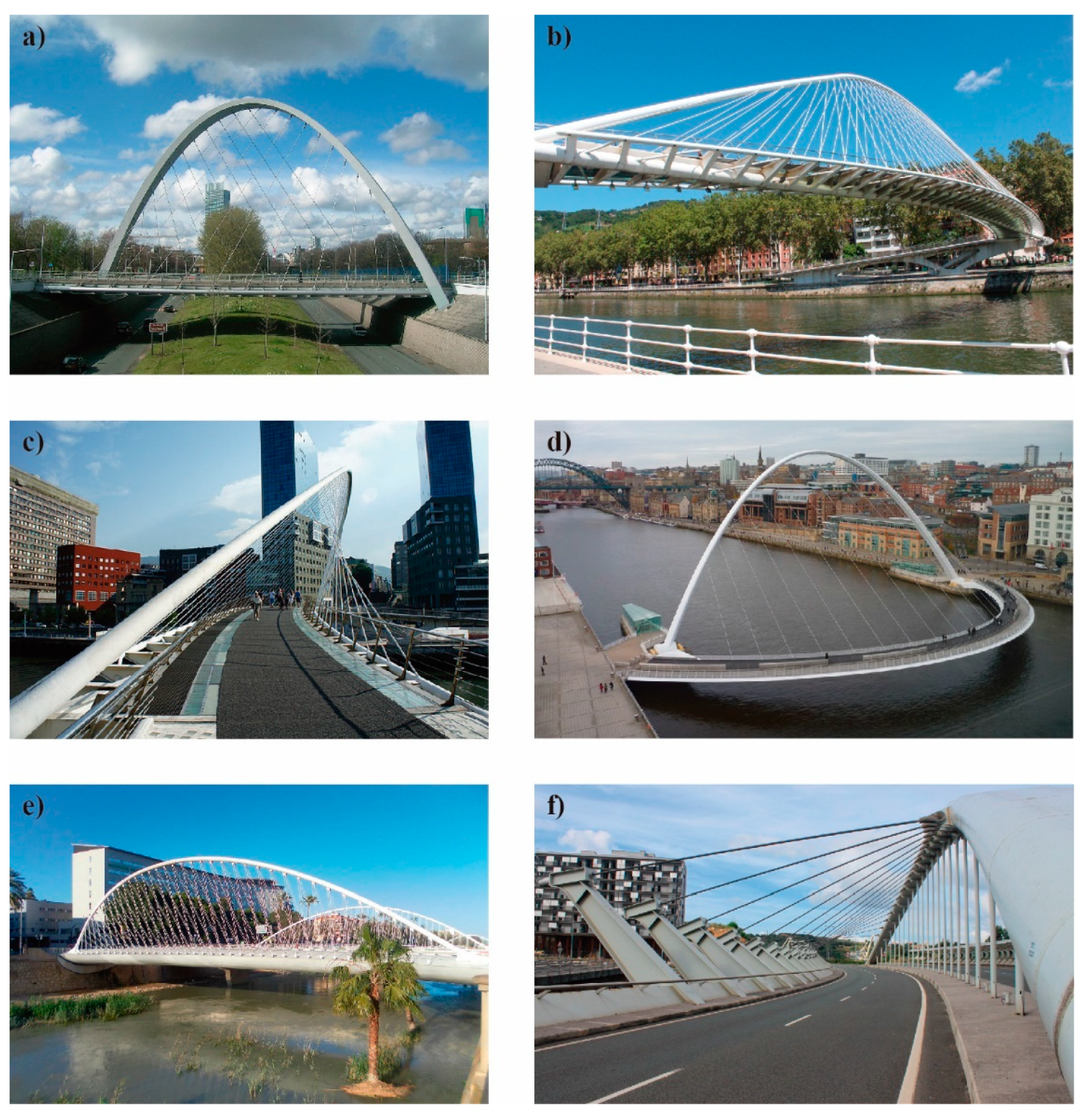

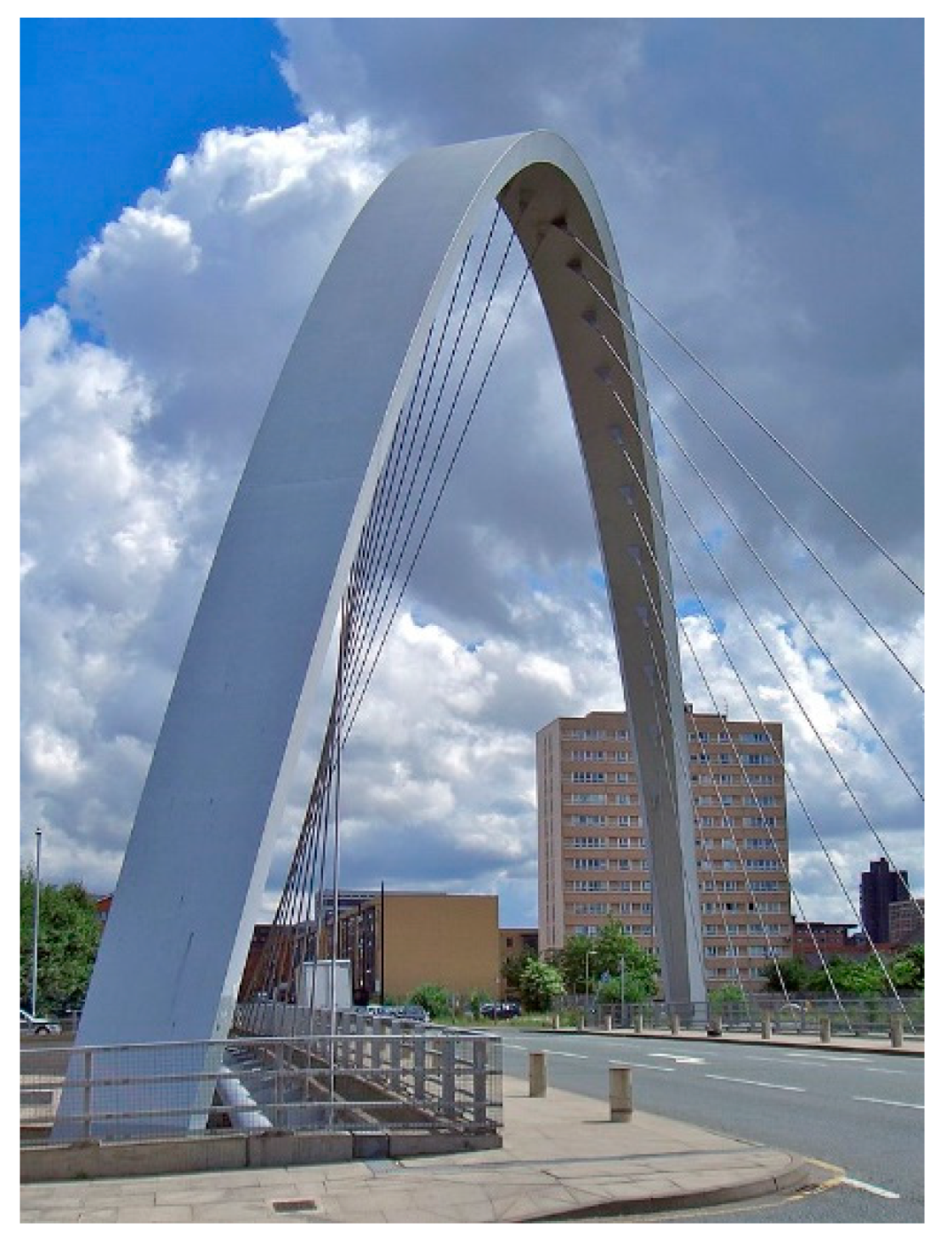



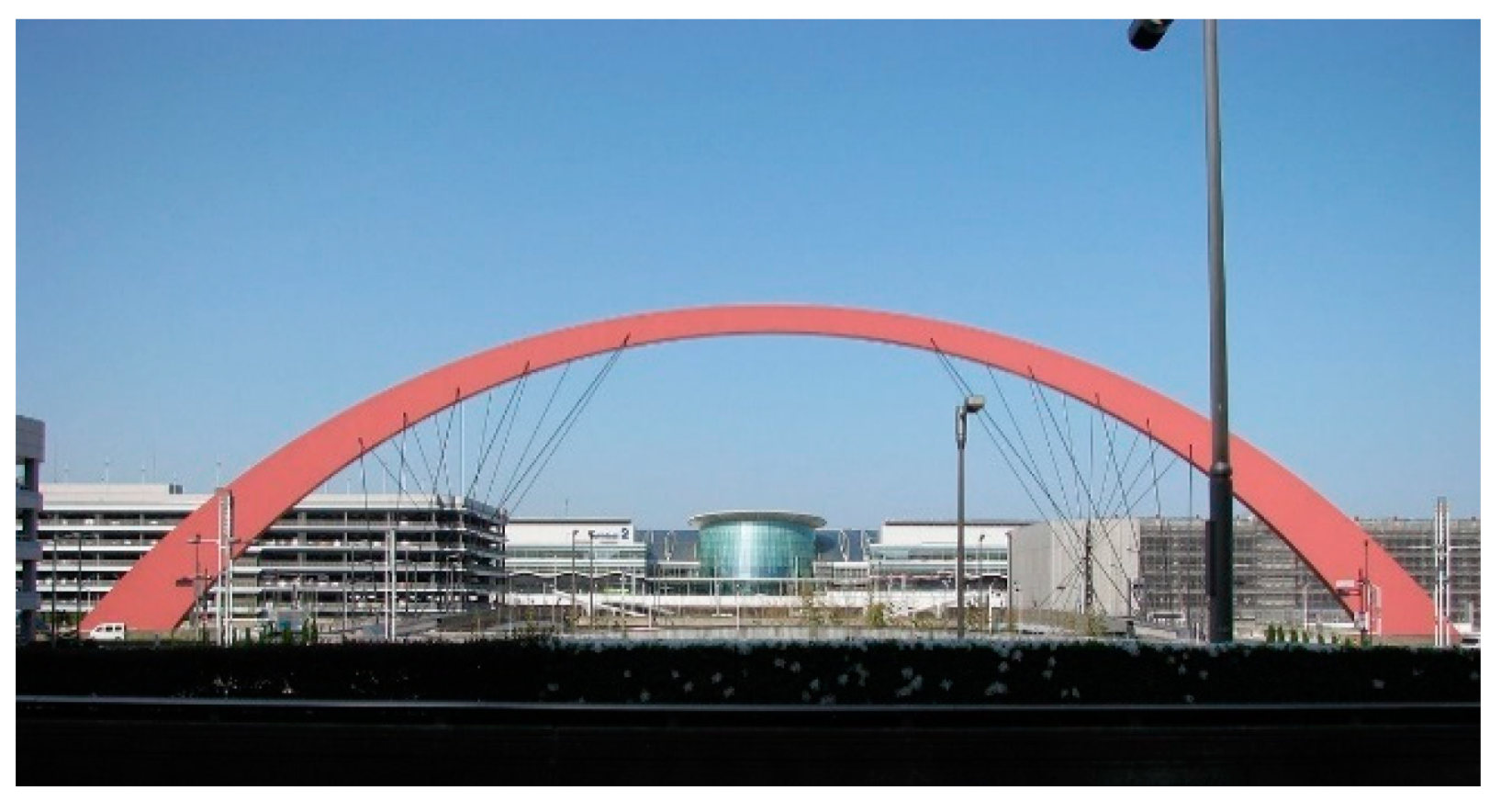

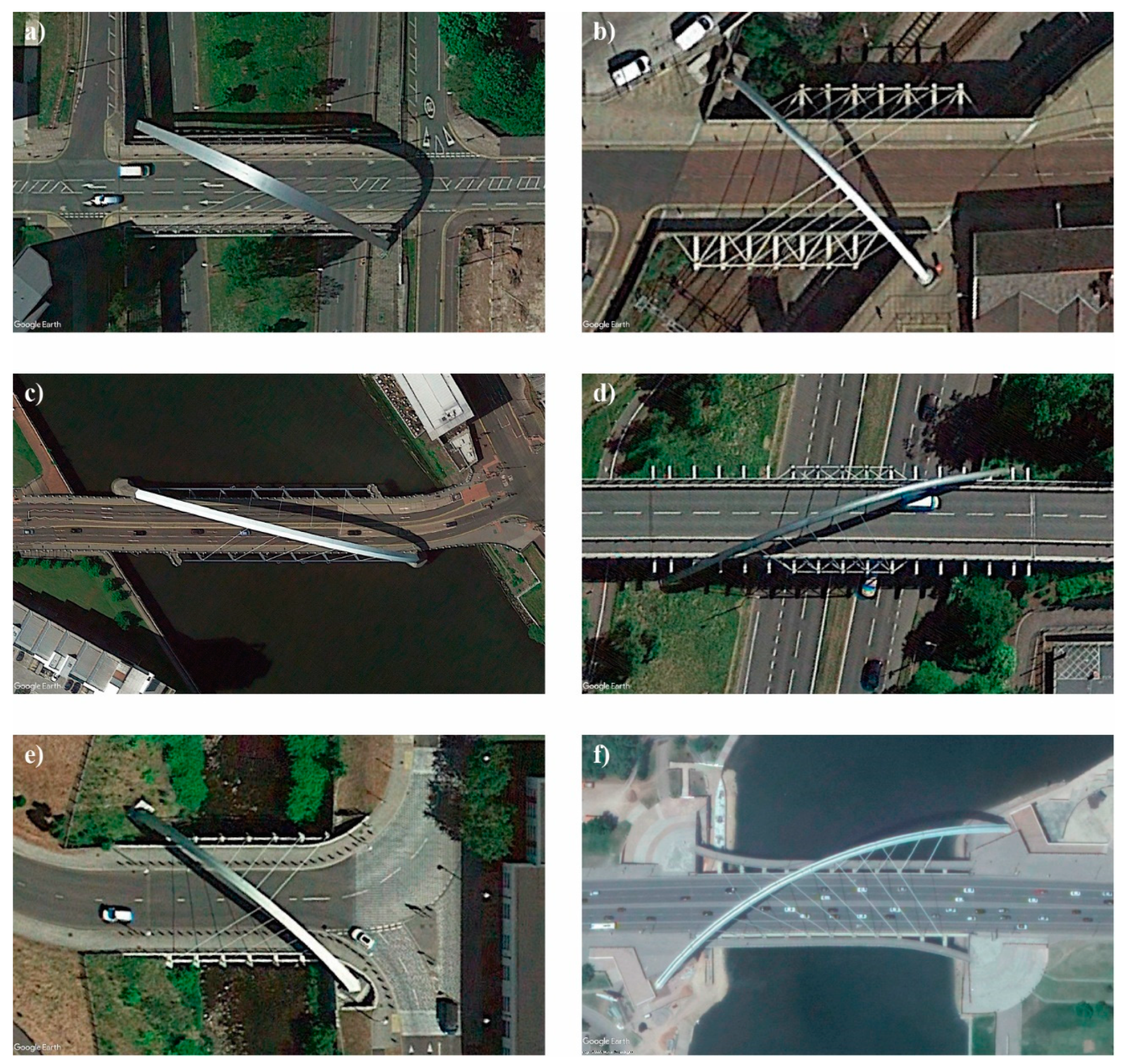
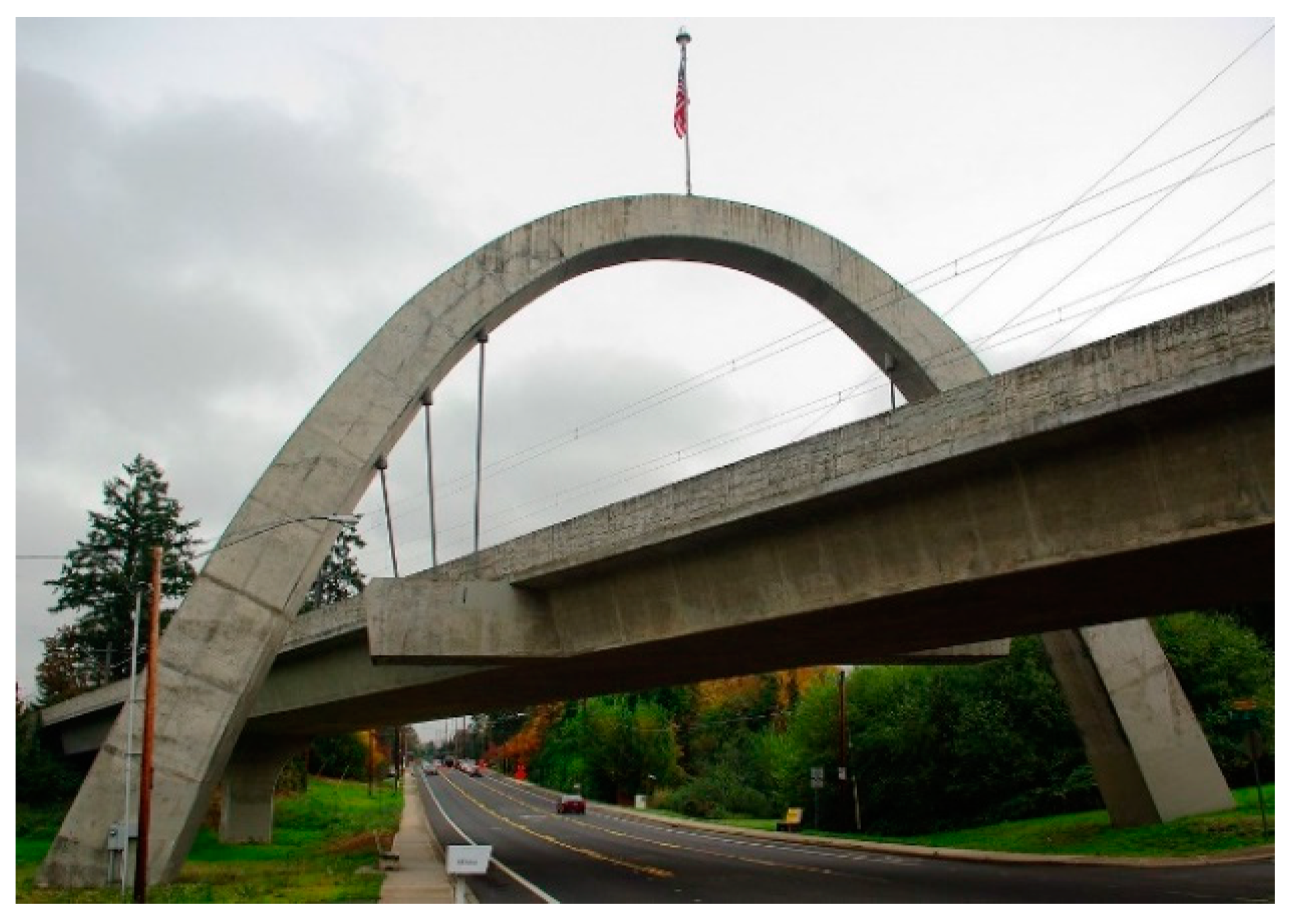
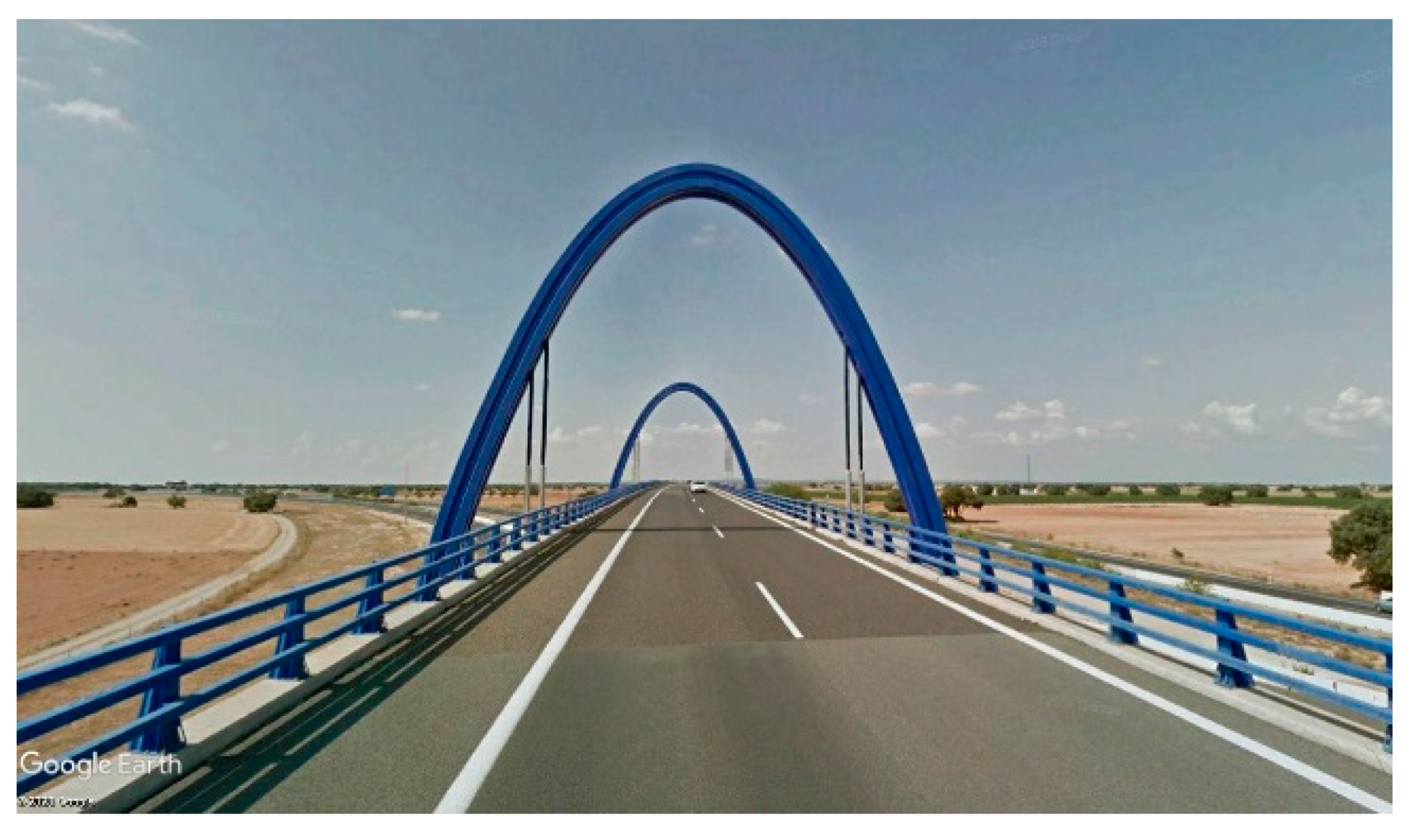
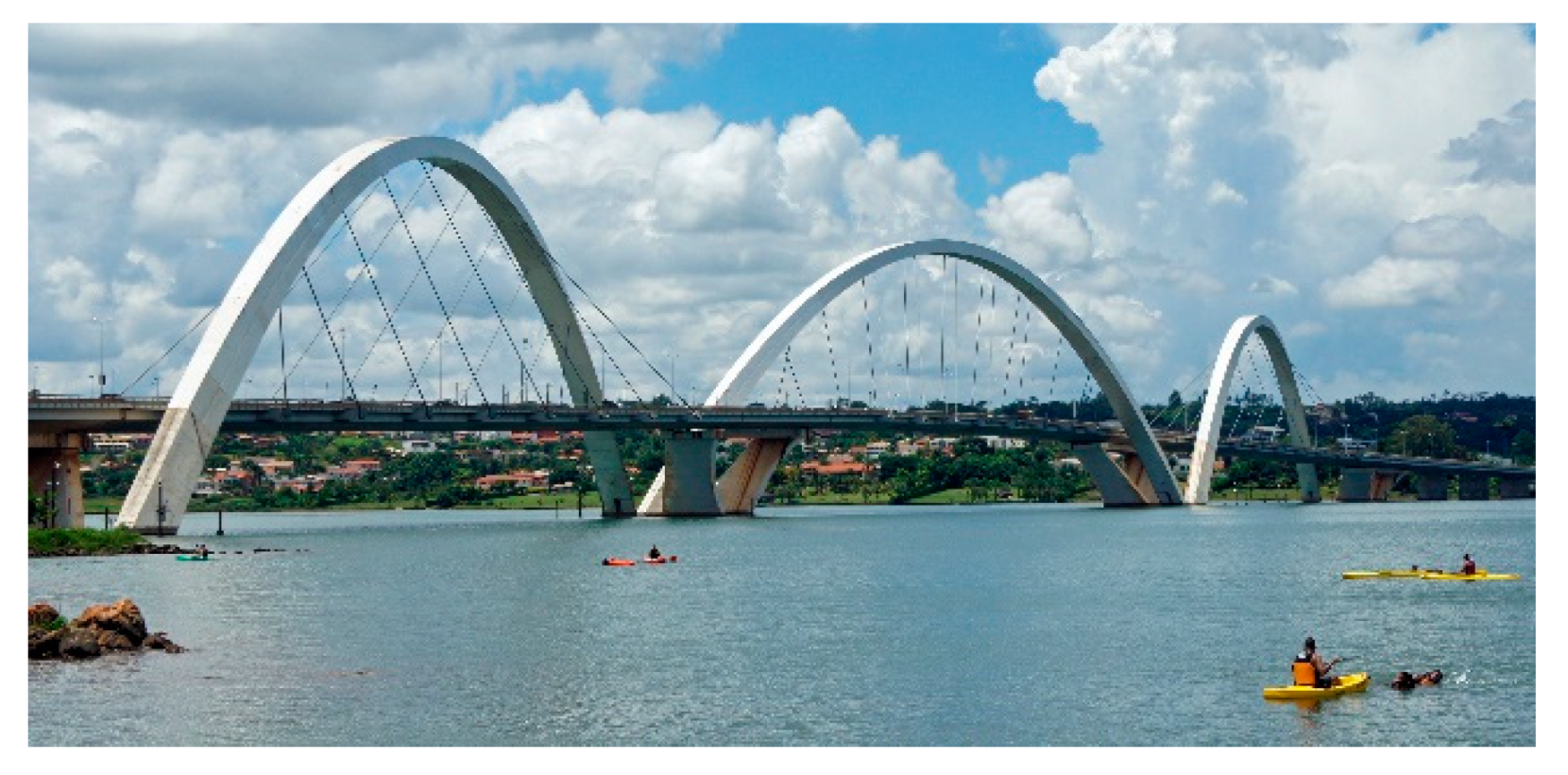
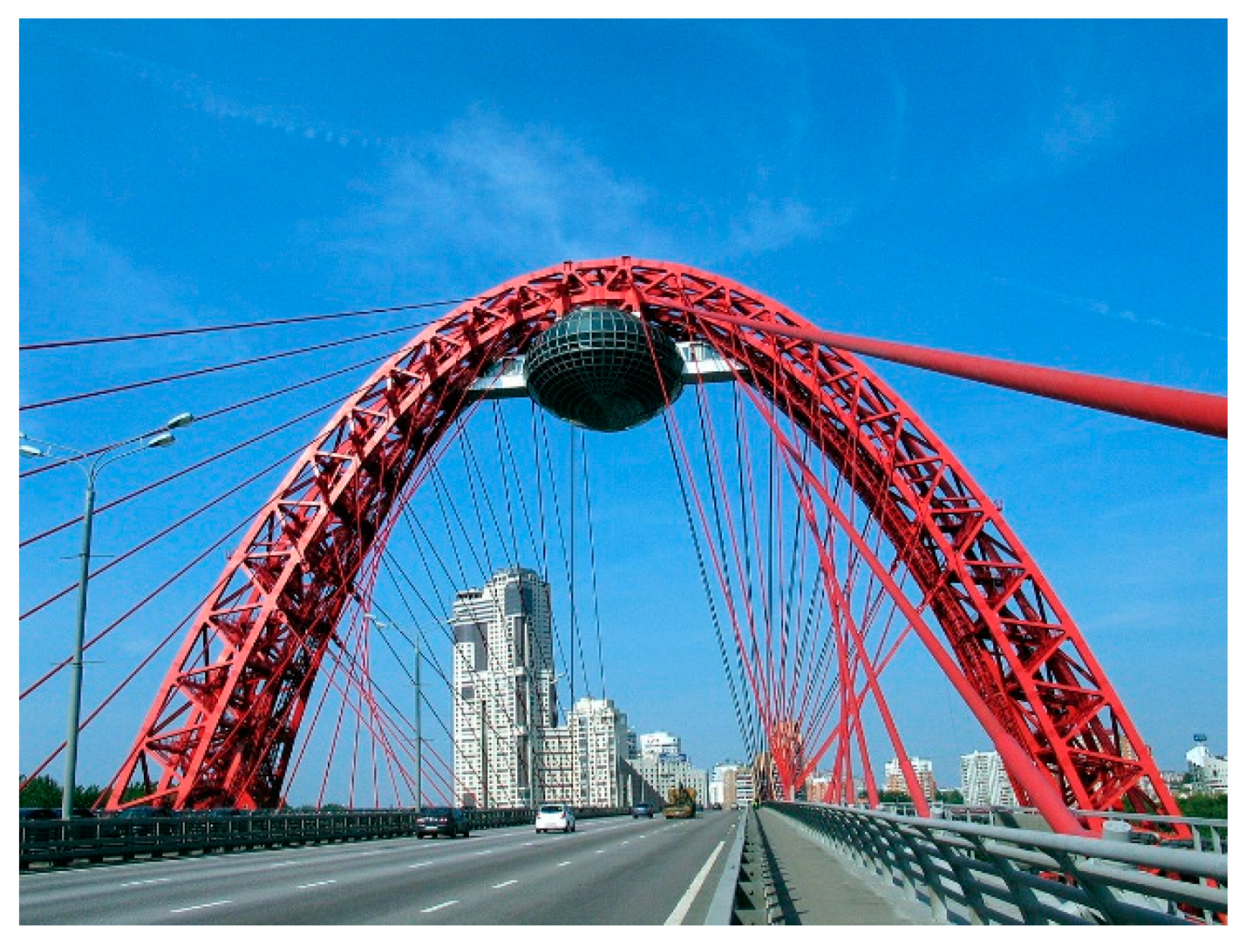
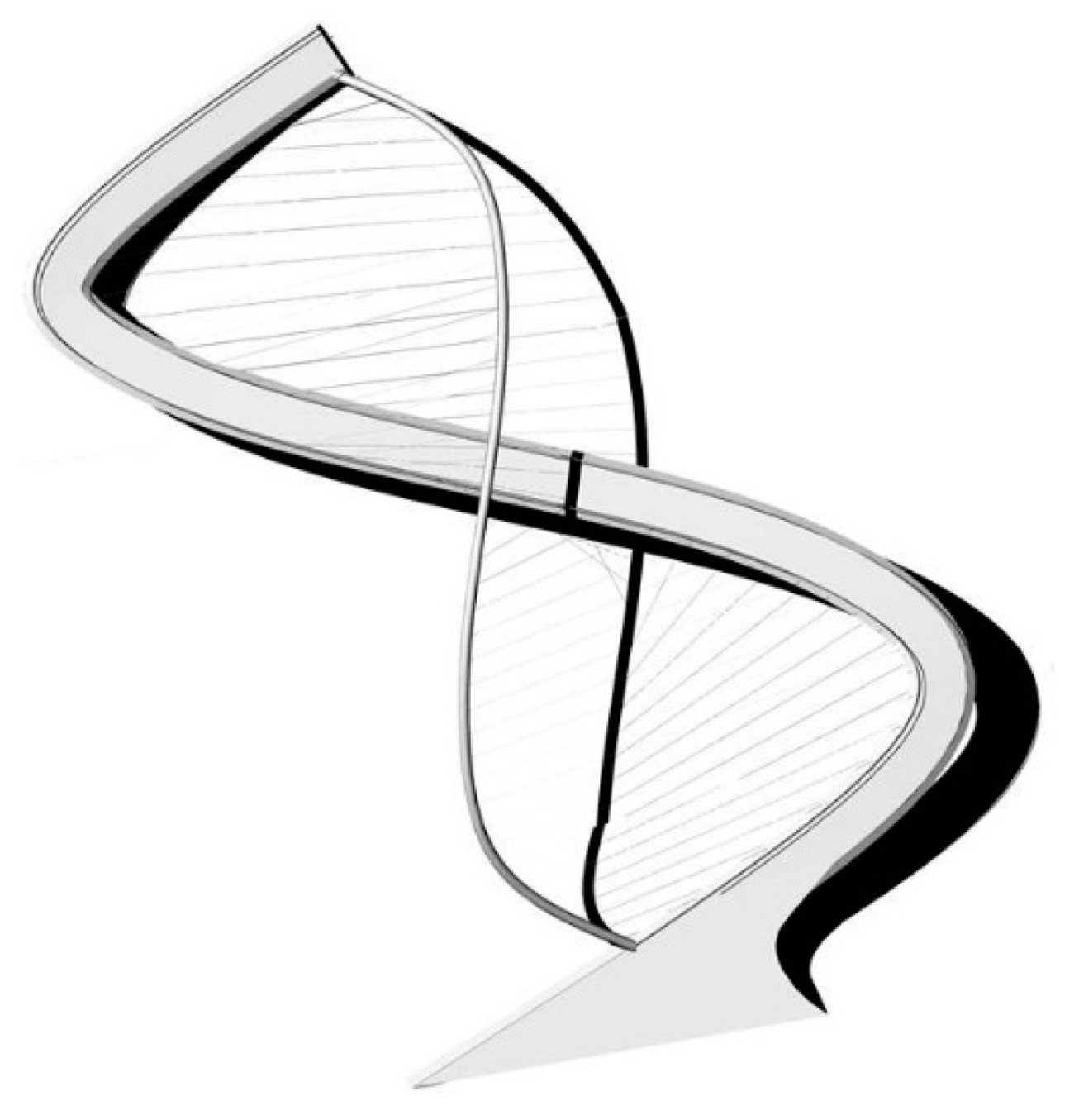

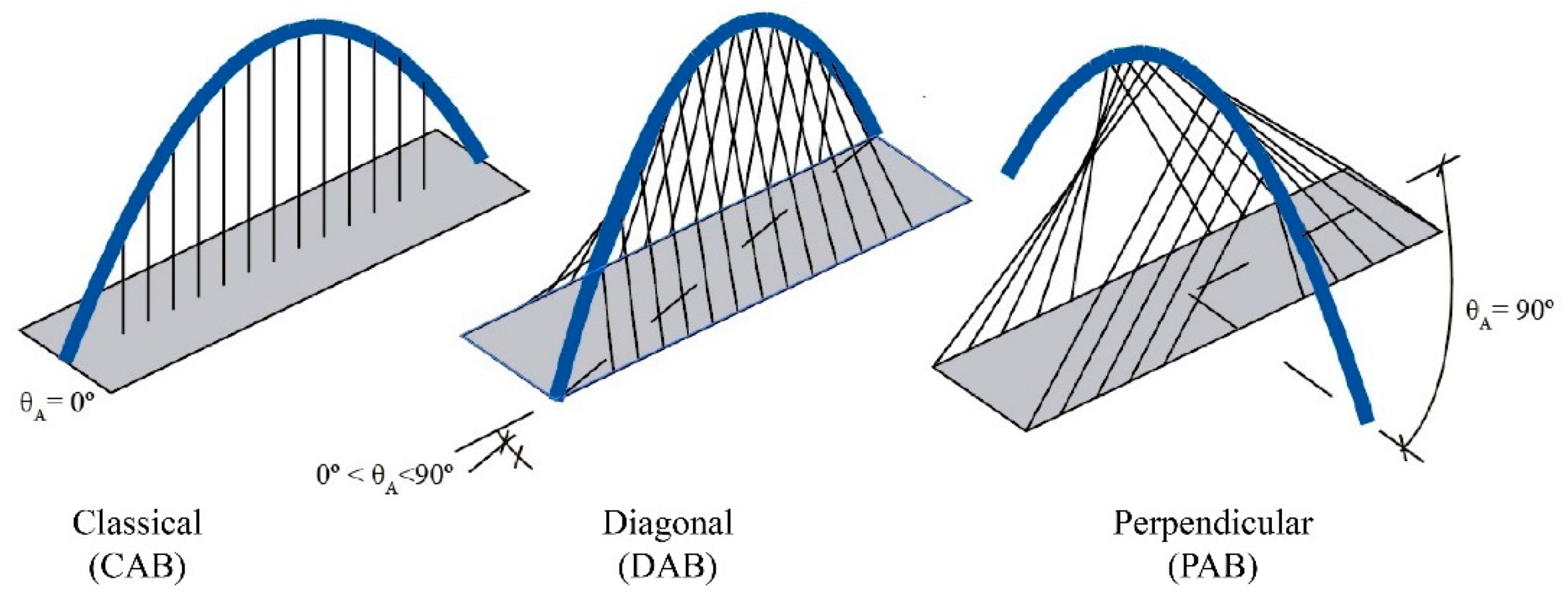

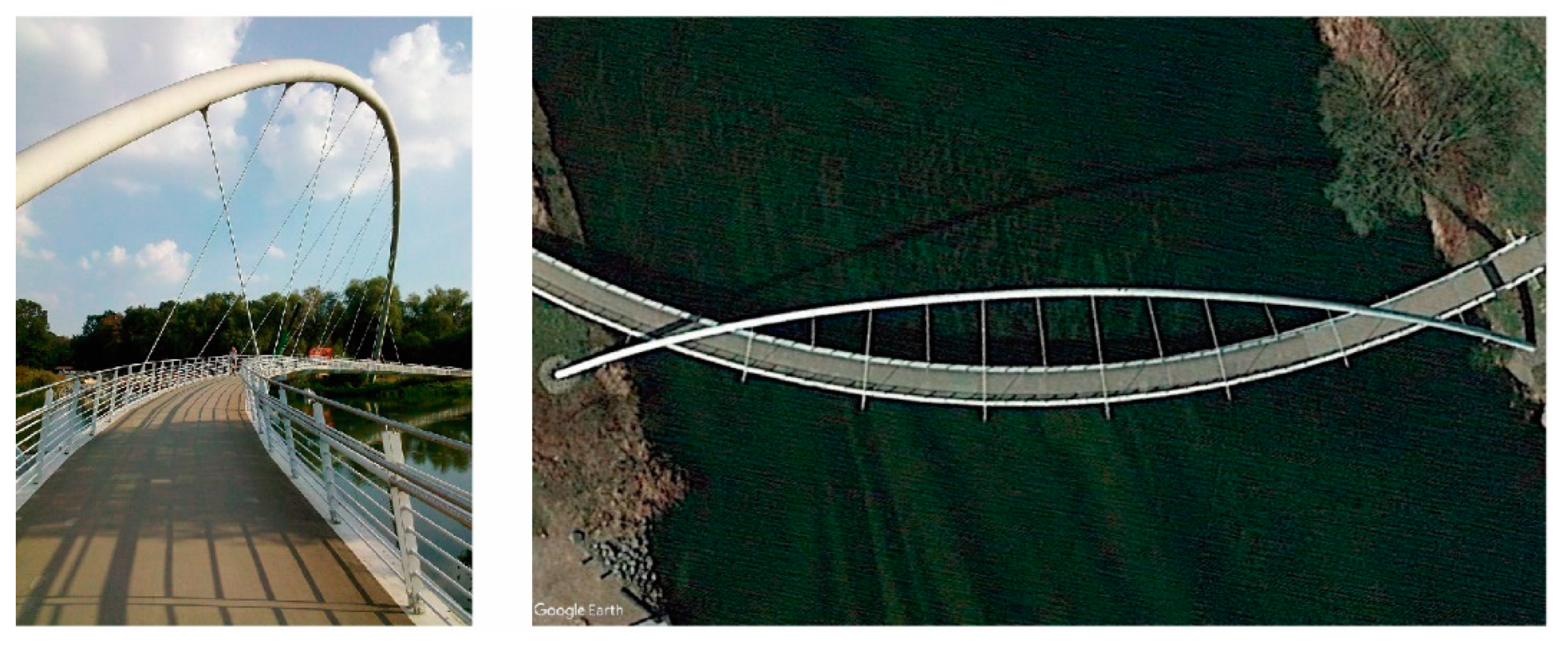


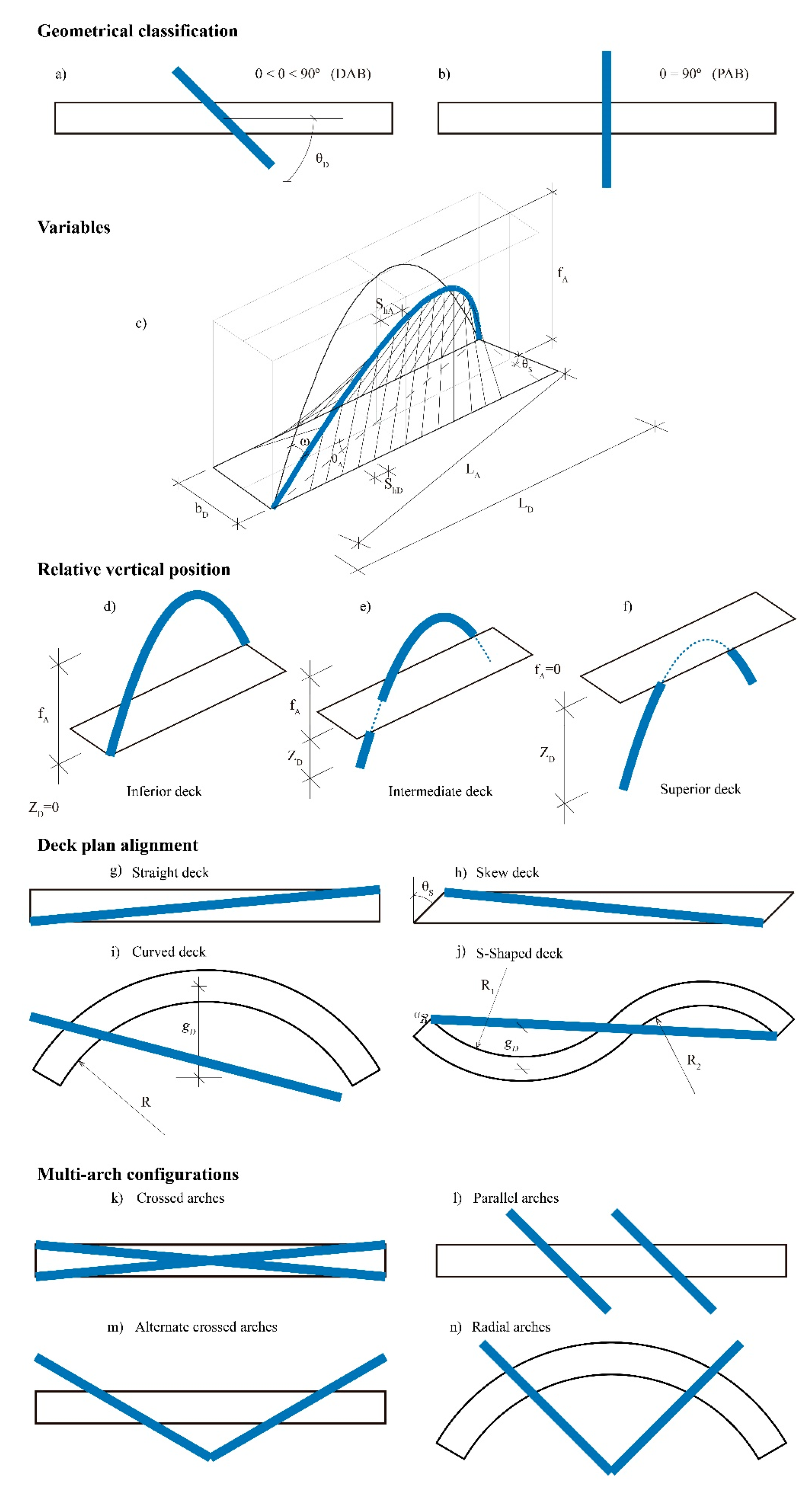

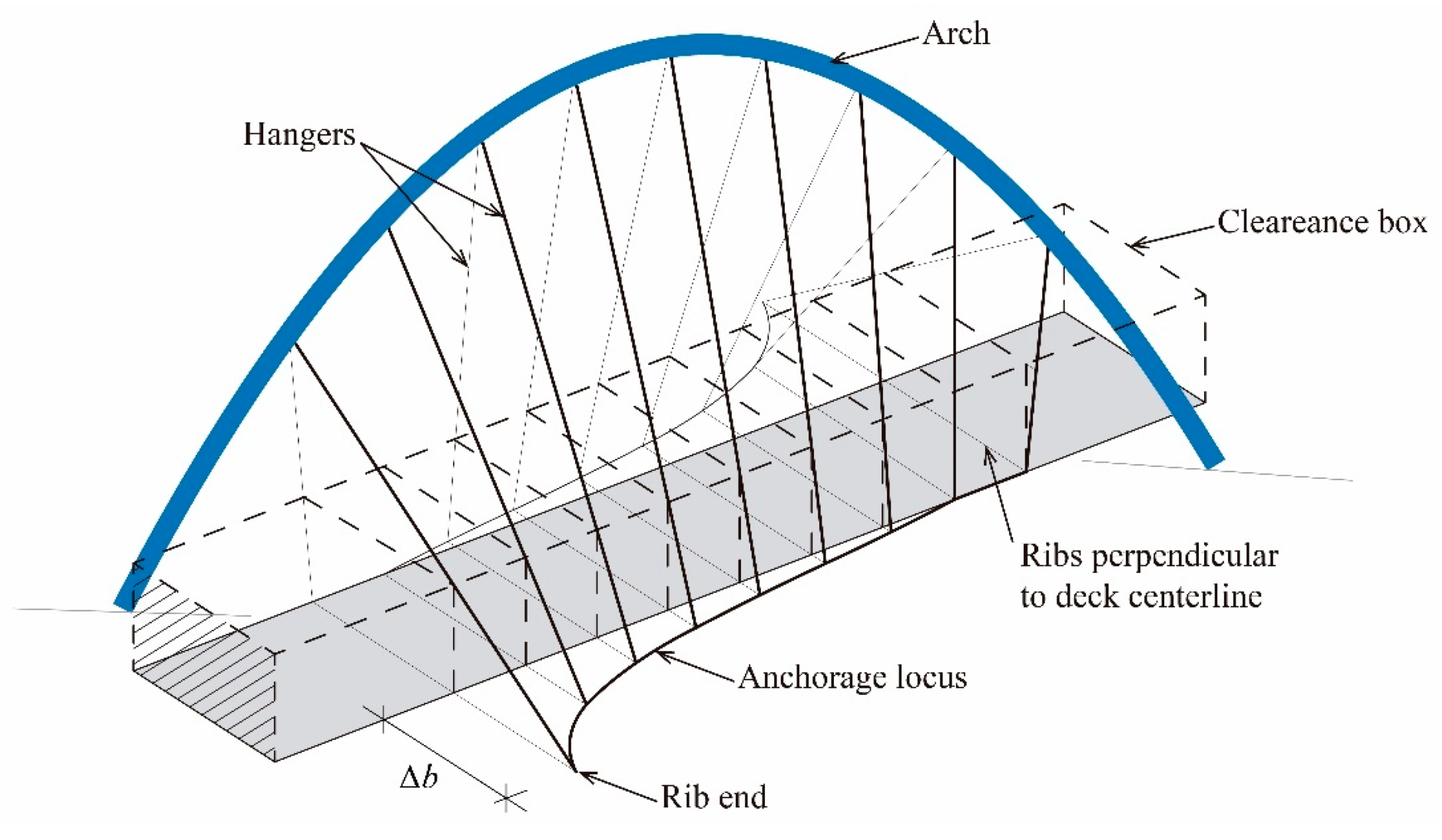
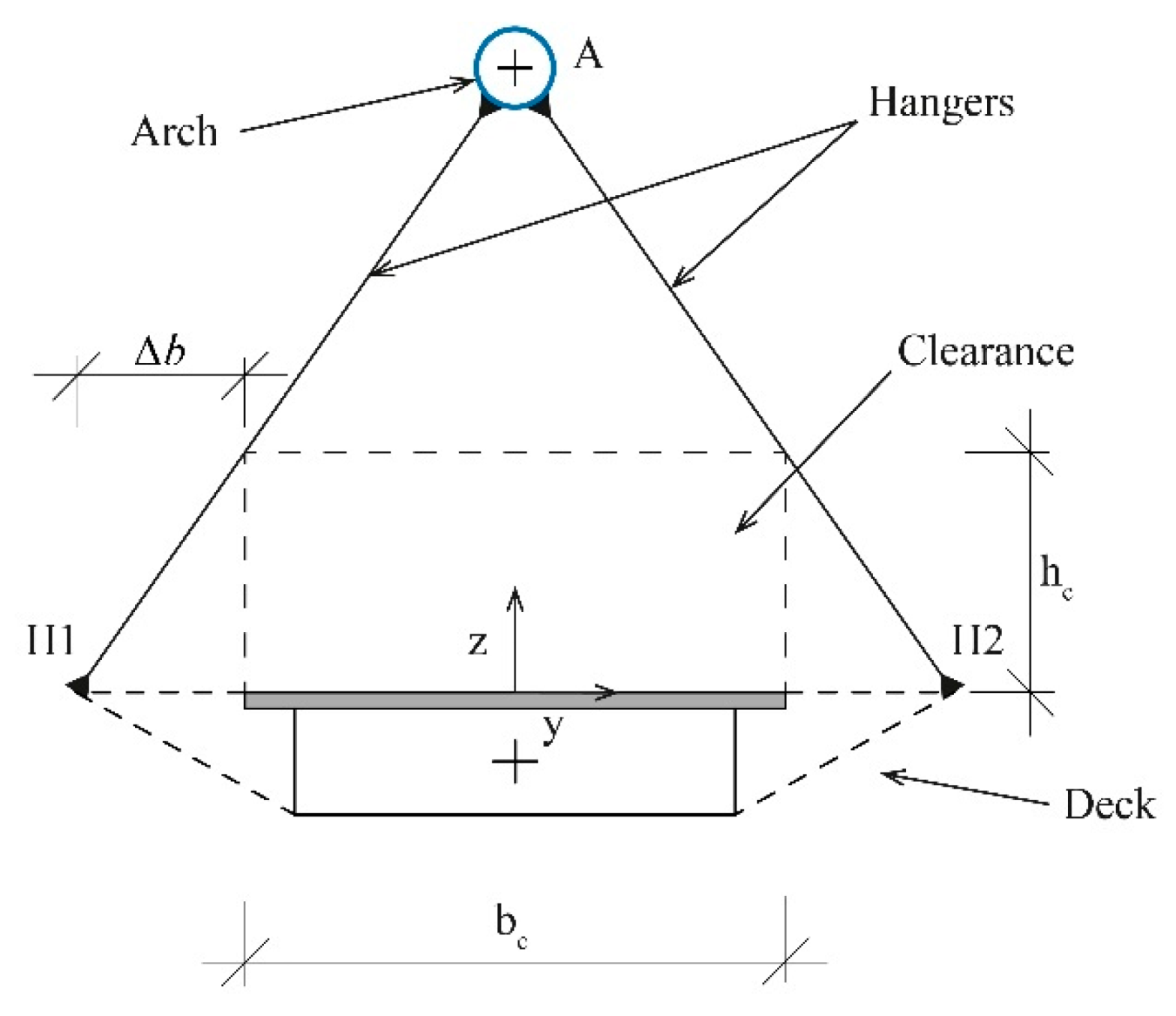

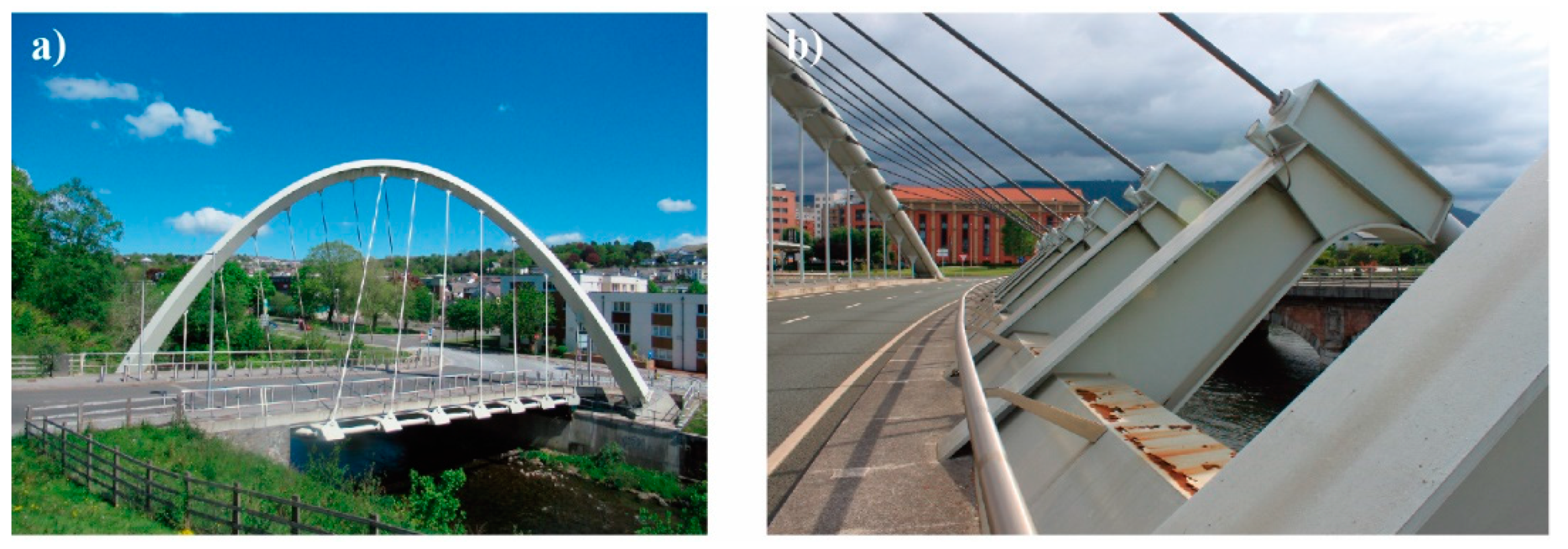
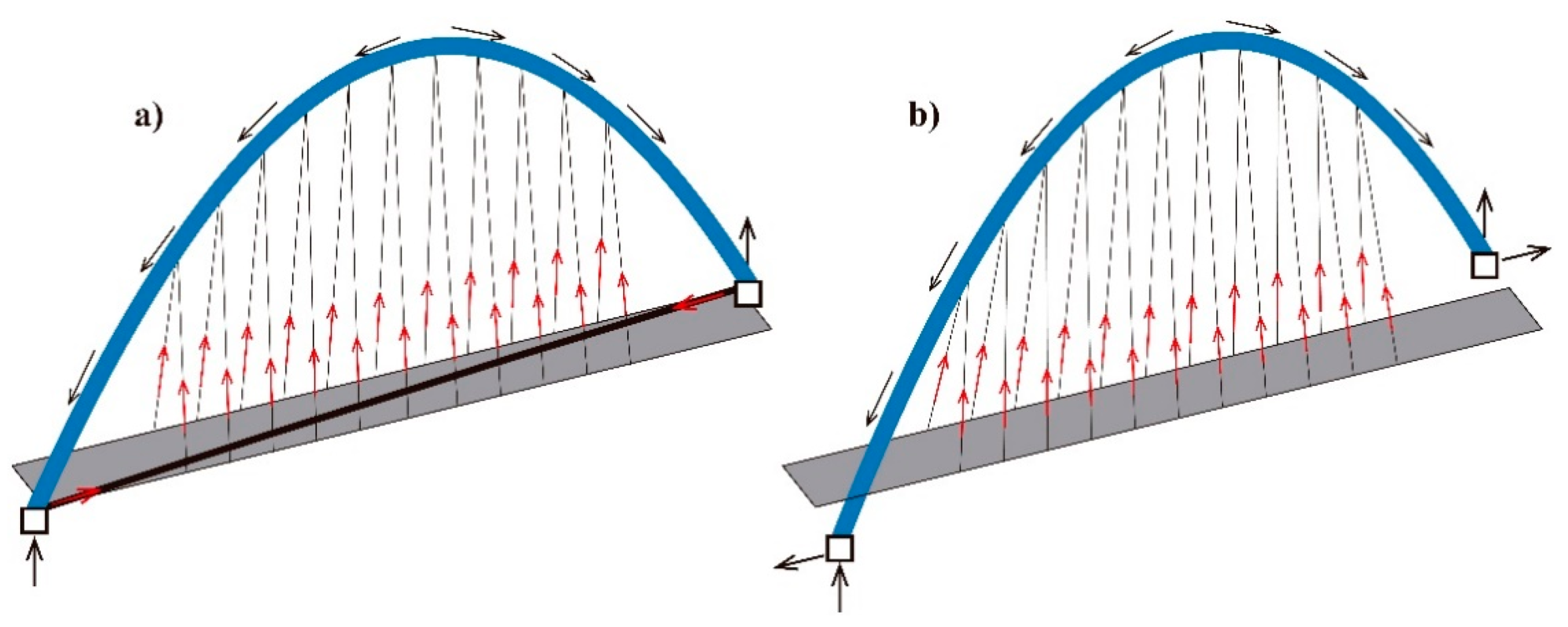
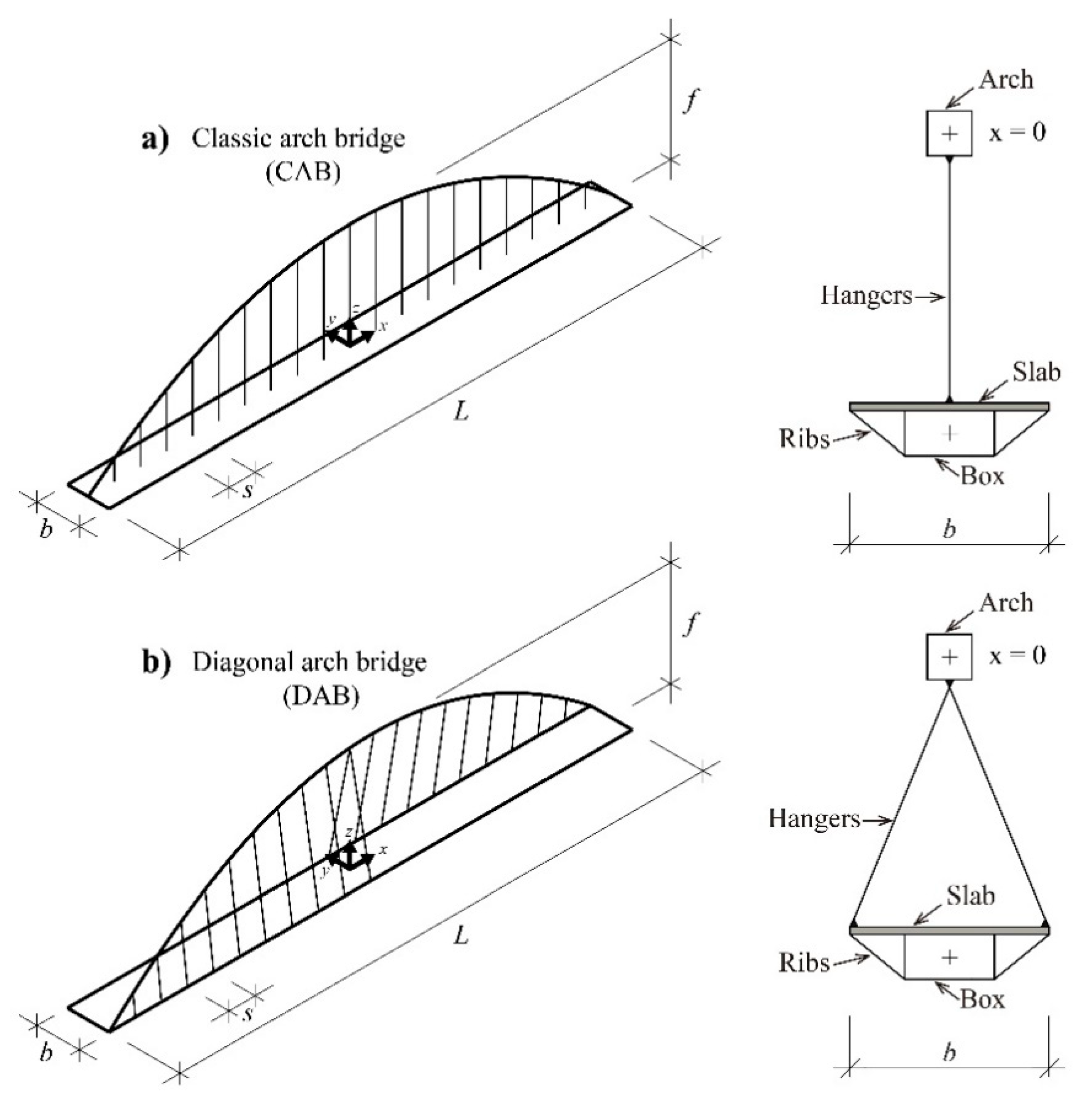

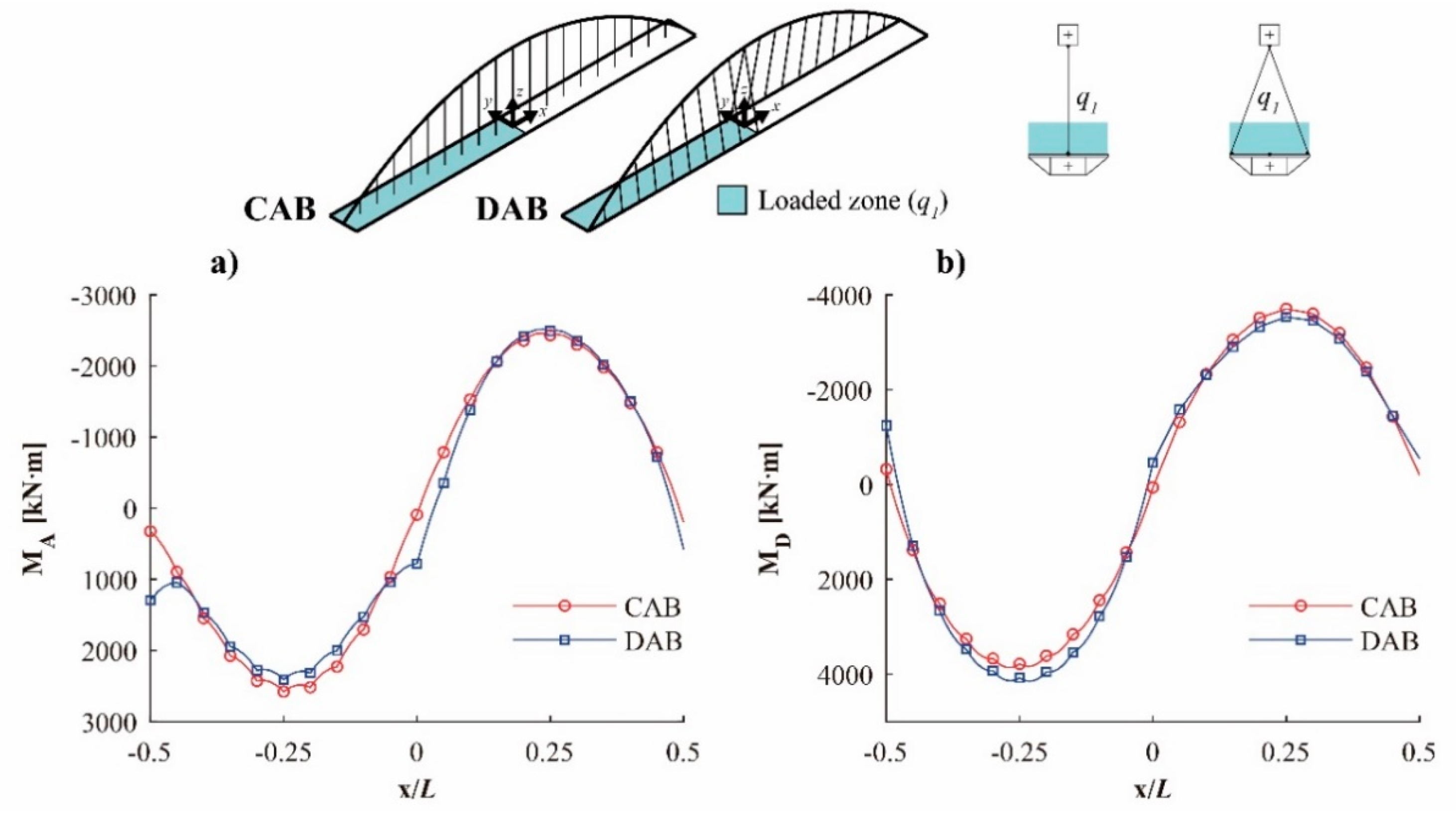
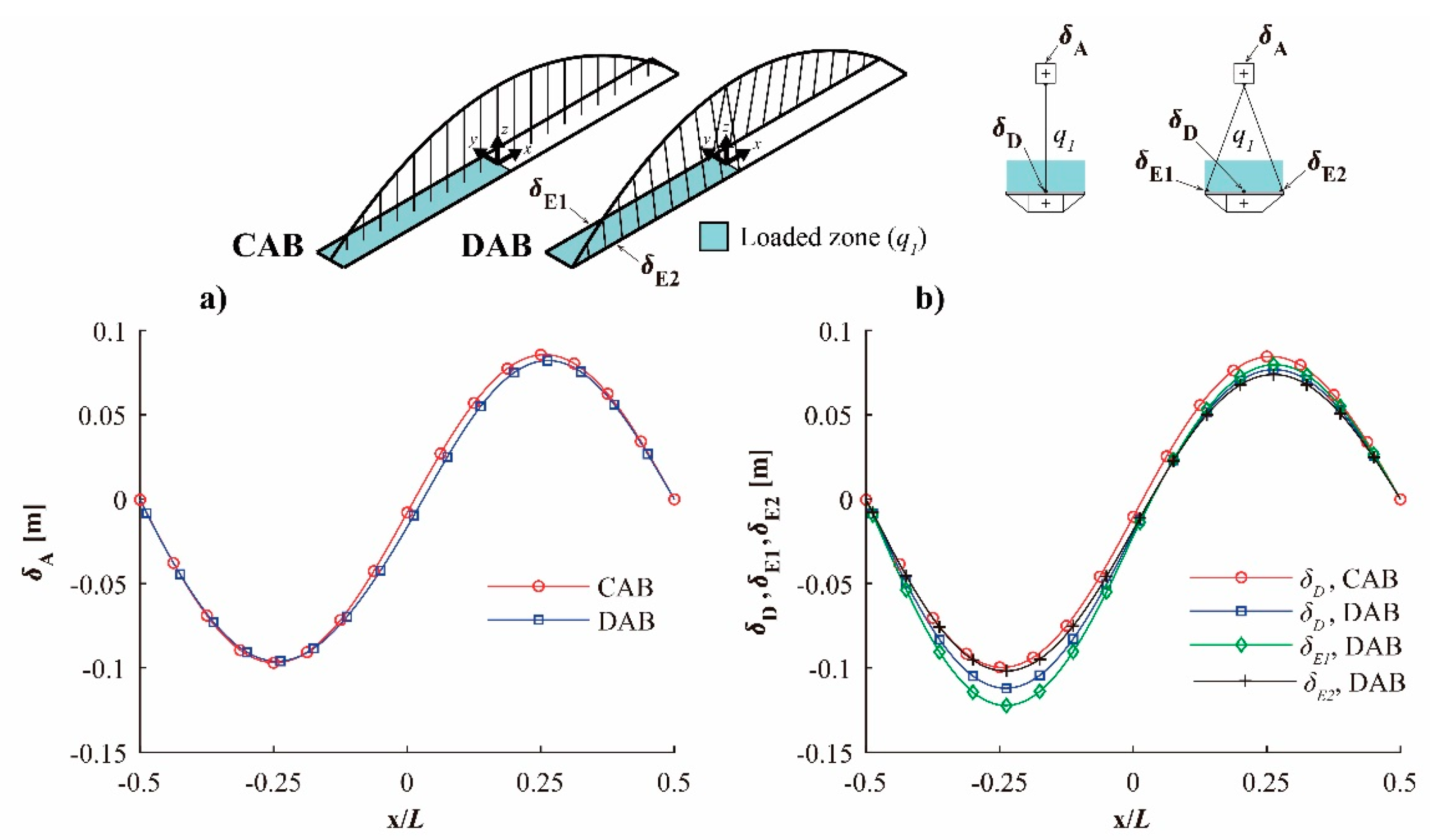
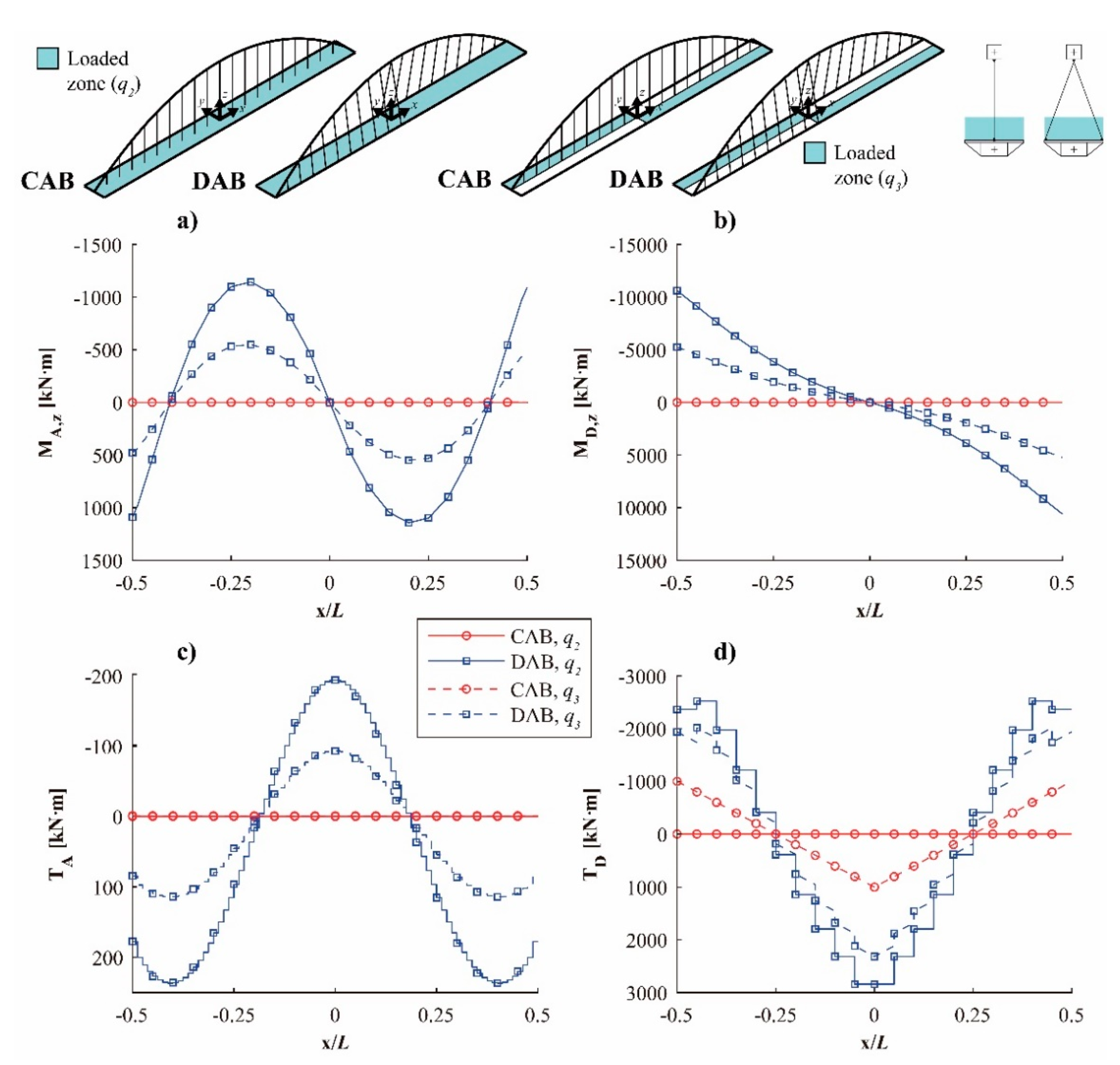

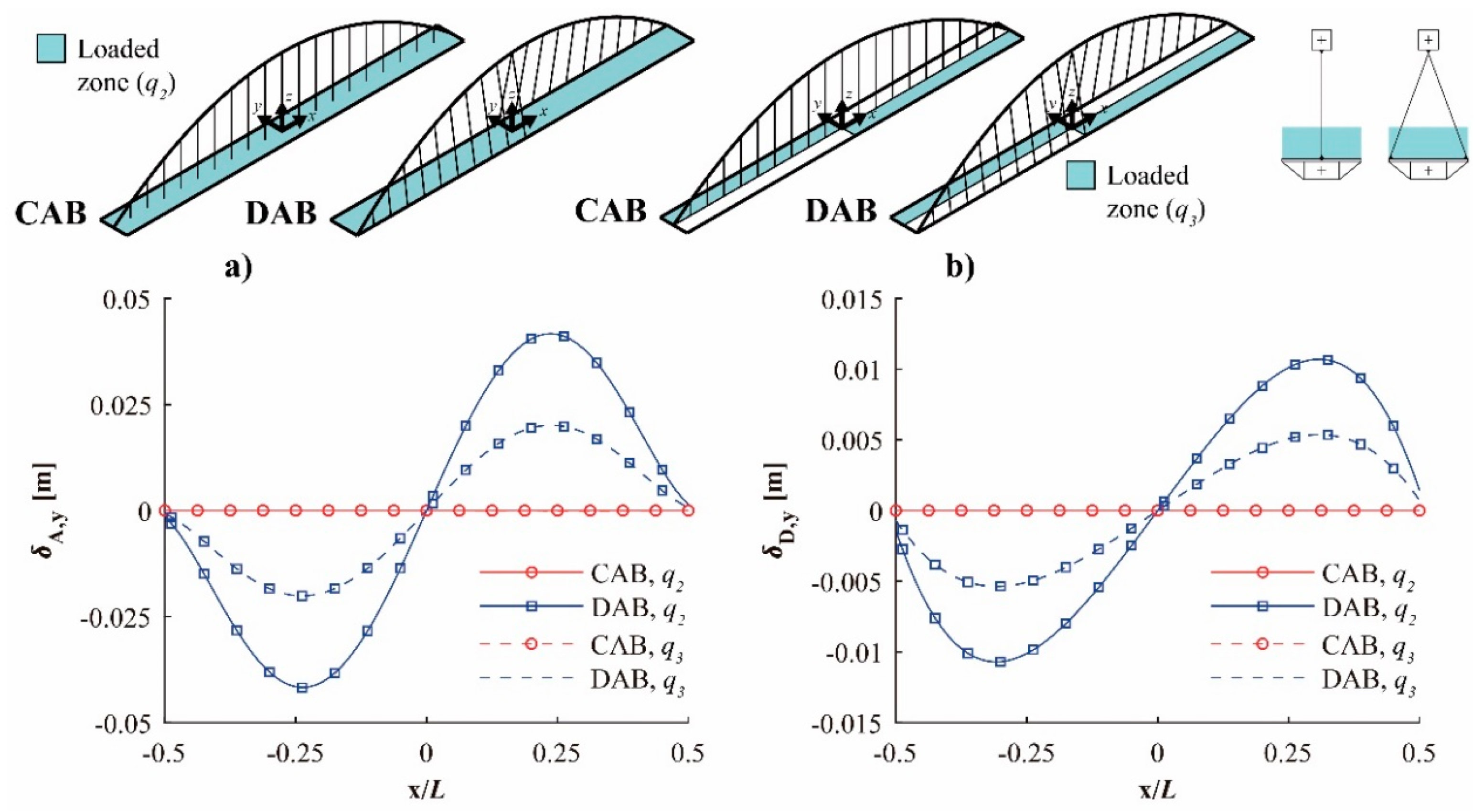

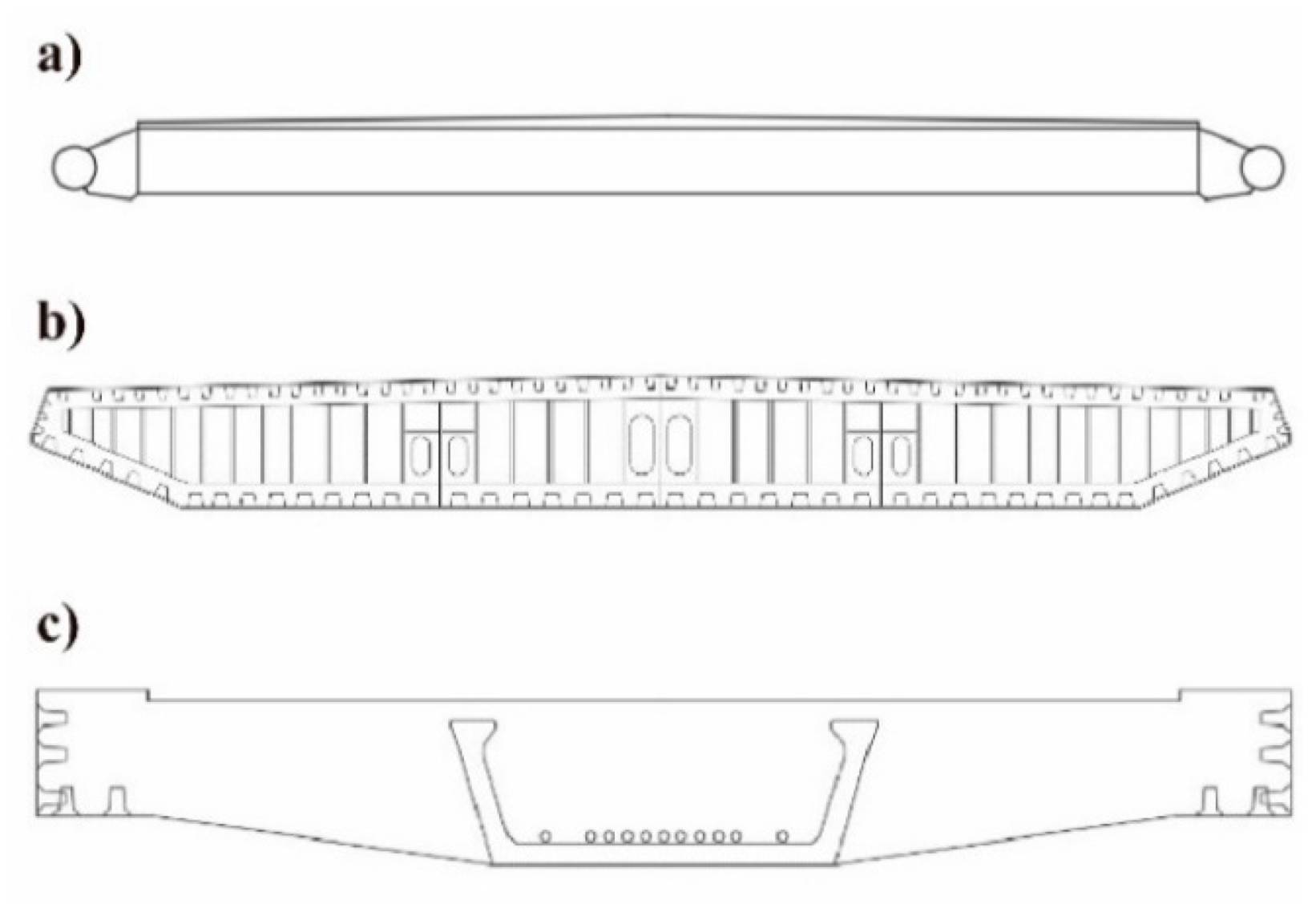


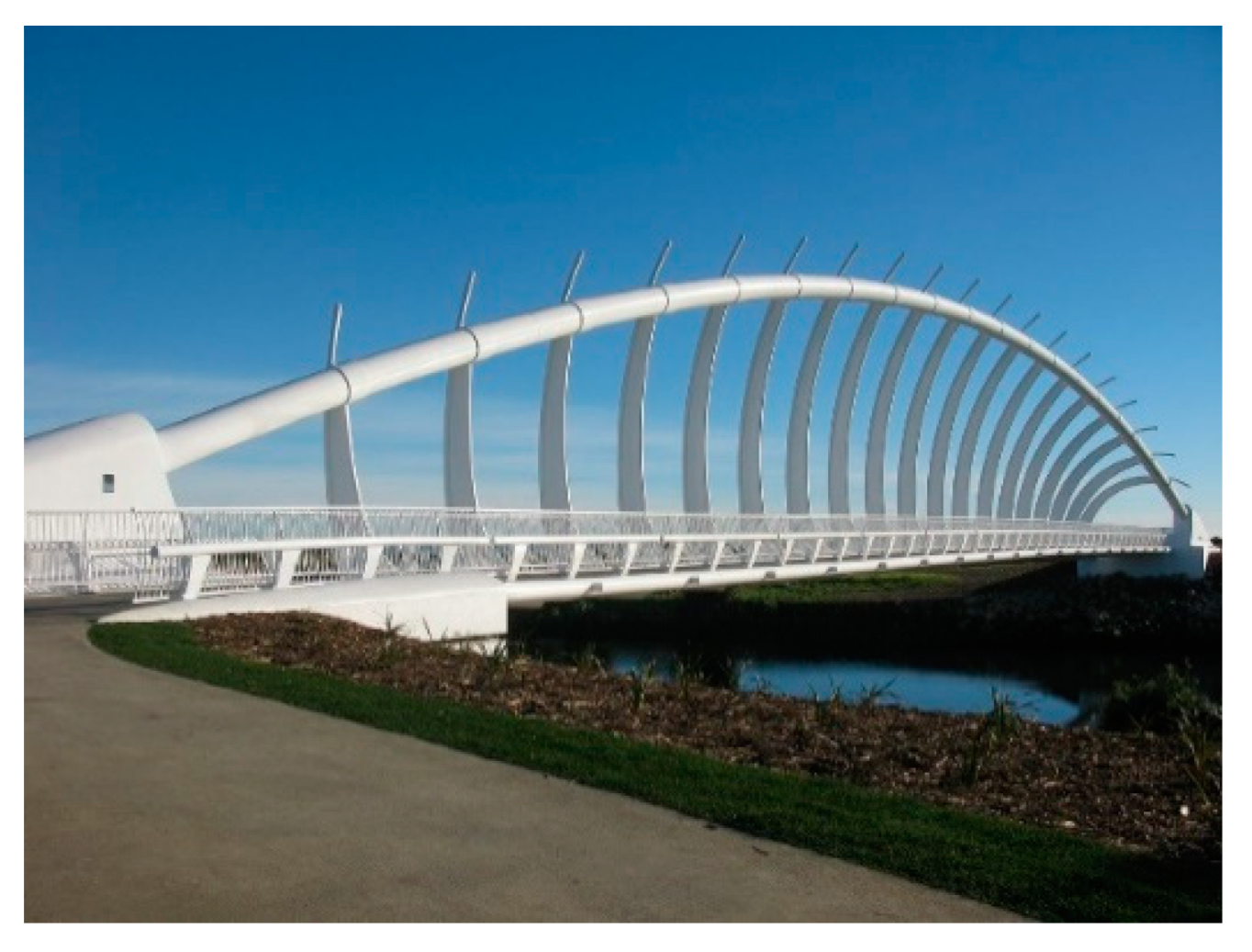
| Structural Element | Cross-Sections | Size 1 | Young’s Modulus (N/mm2) |
|---|---|---|---|
| Arch | Square hollow-box | 1250 × 1250 mm, tf = tw = 30 mm | 2.0 × 105 |
| Hangers | Solid circular | Ø 80 mm | 1.6 × 105 |
| Deck | Rectangular hollow-box | 5000 × 1000 mm, tf = tw = 20 mm | 2.0 × 105 |
Publisher’s Note: MDPI stays neutral with regard to jurisdictional claims in published maps and institutional affiliations. |
© 2021 by the authors. Licensee MDPI, Basel, Switzerland. This article is an open access article distributed under the terms and conditions of the Creative Commons Attribution (CC BY) license (http://creativecommons.org/licenses/by/4.0/).
Share and Cite
Aguilar-Jiménez, J.; García-Guerrero, J.M.; Jorquera-Lucerga, J.J. The Diagonal Arch Bridge, a Particular Case of Spatial Arch Bridges. Appl. Sci. 2021, 11, 1869. https://doi.org/10.3390/app11041869
Aguilar-Jiménez J, García-Guerrero JM, Jorquera-Lucerga JJ. The Diagonal Arch Bridge, a Particular Case of Spatial Arch Bridges. Applied Sciences. 2021; 11(4):1869. https://doi.org/10.3390/app11041869
Chicago/Turabian StyleAguilar-Jiménez, Jesús, Juan Manuel García-Guerrero, and Juan José Jorquera-Lucerga. 2021. "The Diagonal Arch Bridge, a Particular Case of Spatial Arch Bridges" Applied Sciences 11, no. 4: 1869. https://doi.org/10.3390/app11041869






